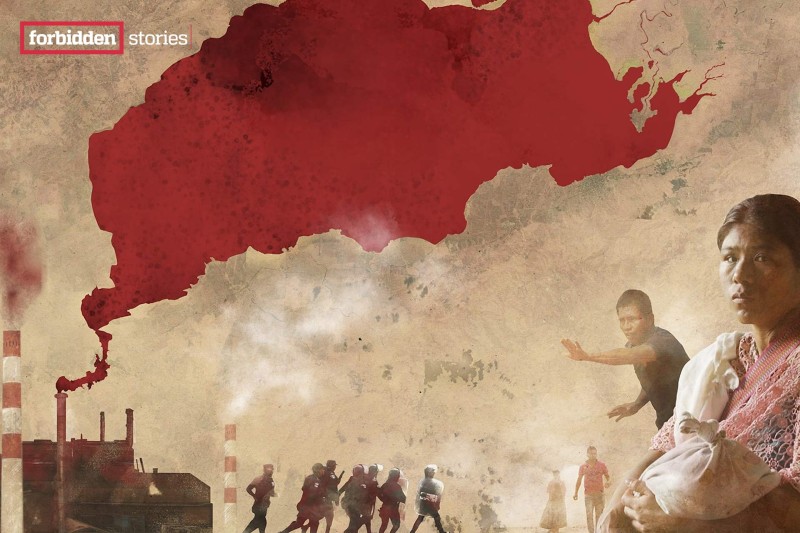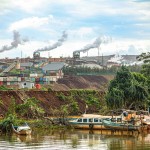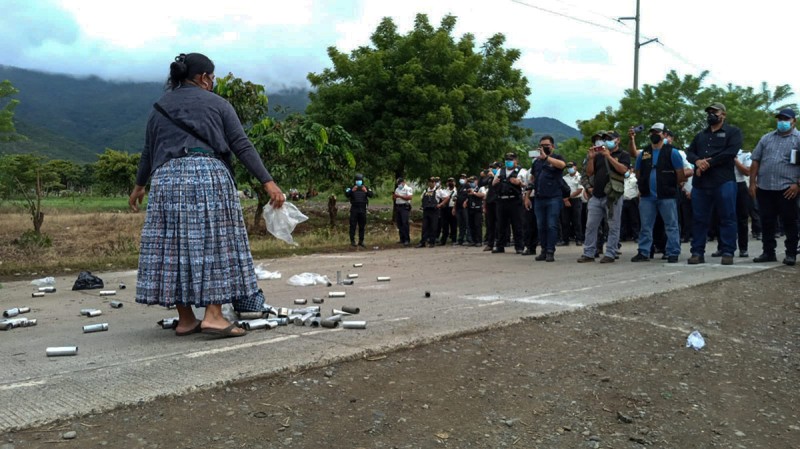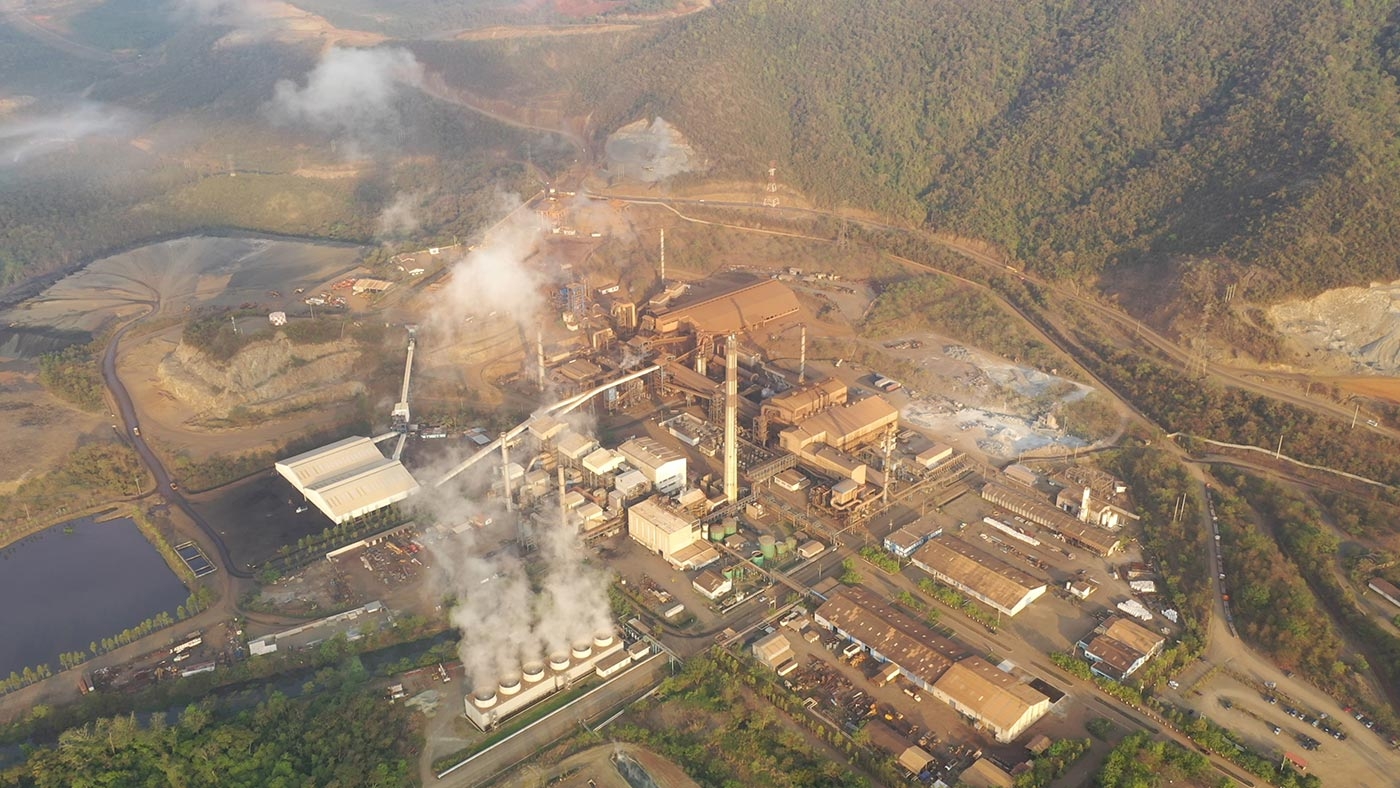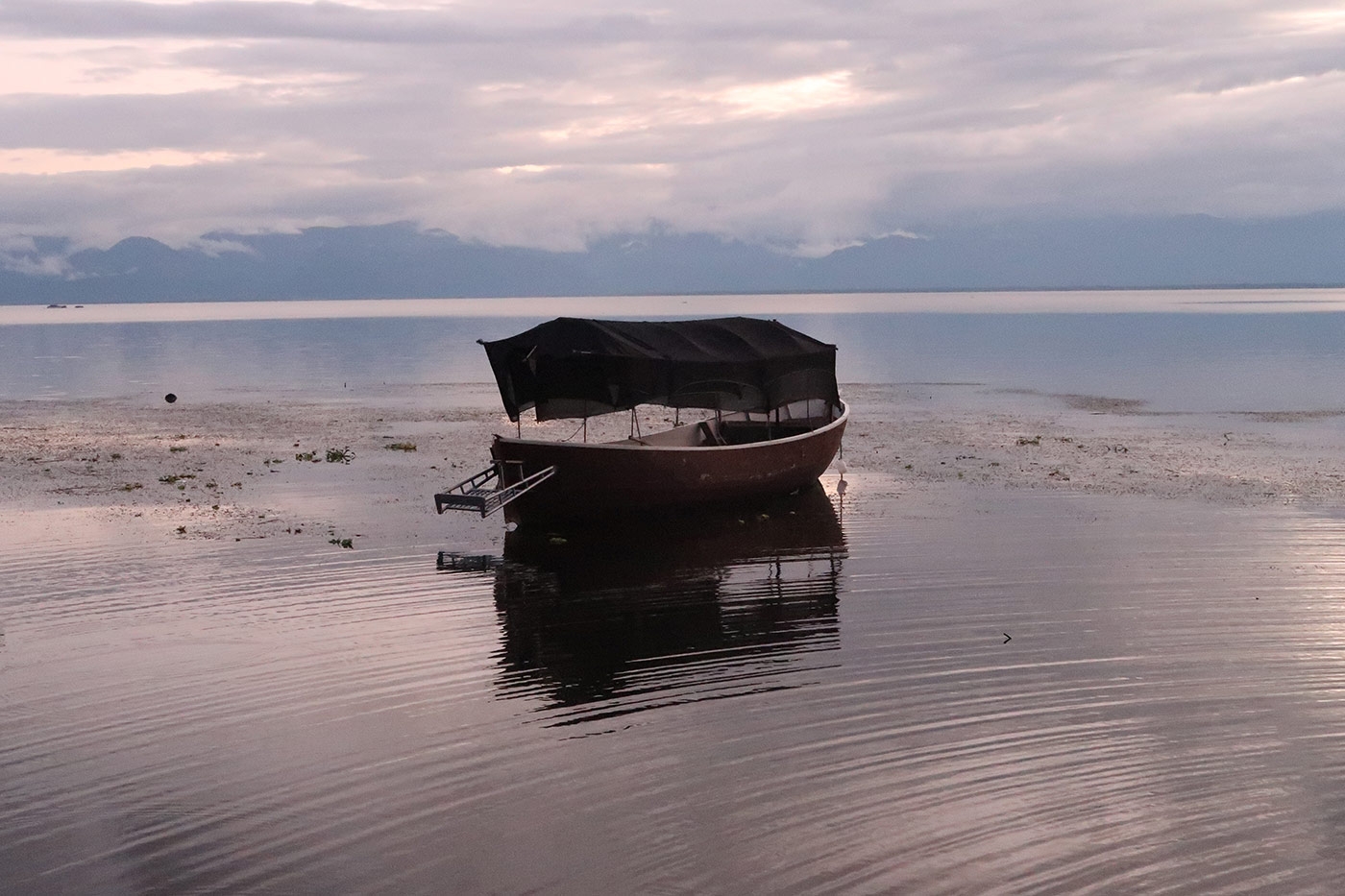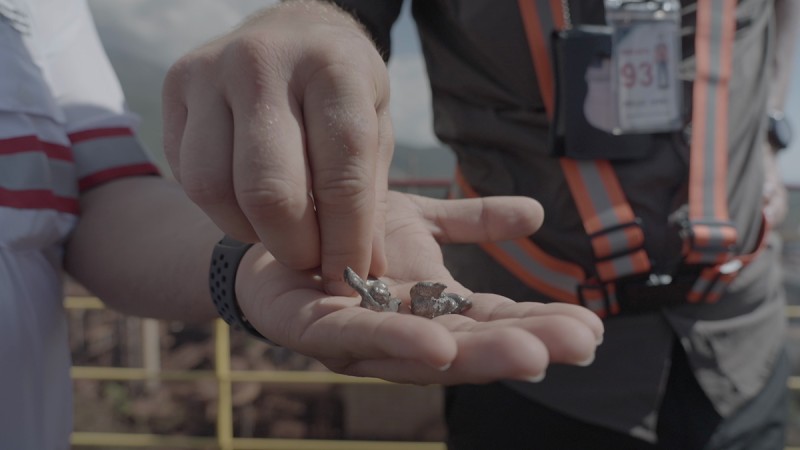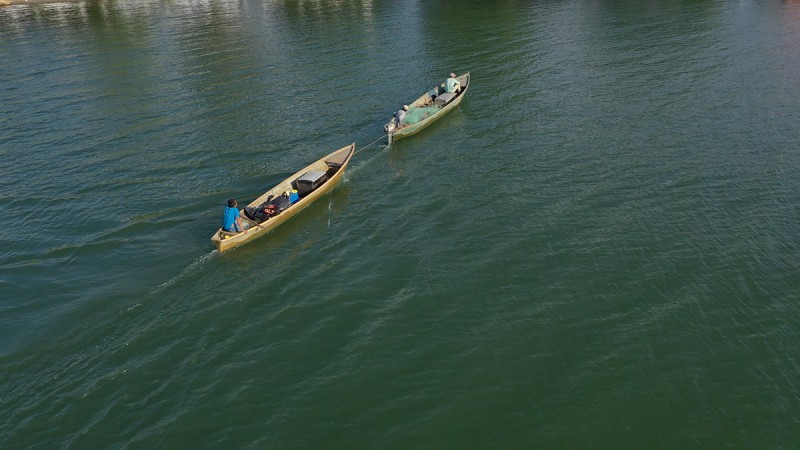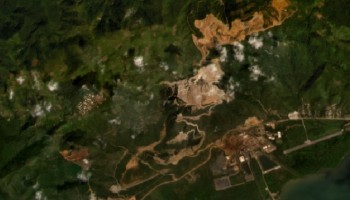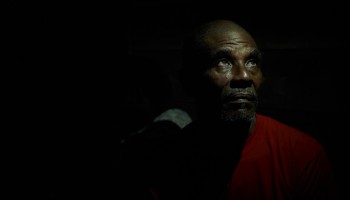Olga Marina Ché Ponce wasn’t home the day the police came. When officers stormed into her house in El Estor, in the east of Guatemala, they found only her 18-year-old son and toddler daughter at home. They ransacked the place, eating her food and killing several of her animals.
Police raided dozens of houses in El Estor belonging to people who had been protesting against the nearby Fénix mine in late October. For three weeks, residents had tried to block trucks from entering and leaving the site, but they were met with tear gas, beatings, and arrests. As clashes escalated, authorities declared a month of martial law, including a dusk-to-dawn curfew.
Authorities act like “we are terrorists, when it is not true. We are asking for our rights,” Ché told OCCRP partner The Guardian in January. “We do this so that the community has a clean environment, better water, a better place to live without pollution.”
Fénix is one of the largest nickel mines in Central America and has customers around the world, including major Finnish stainless steel maker Outokumpu, which has supplied Ikea and Bosch-Siemens, as well as the Burj Khalifa tower in Dubai.
For years, many locals have battled against the mine, which they say has polluted the air and poisoned Guatemala’s largest body of freshwater, Lake Izabal. The company that operates it, Swiss-registered Solway Investment Group, has disputed their complaints, saying it protects the environment and follows the law.
But behind the scenes, Solway has been telling a very different story.
Leaked documents from inside the mining group, shared with OCCRP and 19 other media agencies by Forbidden Stories, which led the investigation, show Solway executives have long hidden evidence that the company was leaching contaminated water into Lake Izabal.
The most stark example comes from 2017, when fishermen staged protests about a strange red slick that was spreading across the lake. Publicly, Solway blamed a bloom of algae for the discoloration, but internal reports and emails show managers in its Guatemalan companies knew red-stained water was spilling from the mine’s site.
Reporters shared Solway’s own water and sediment analysis, contained in the leaked data, with four independent experts. All of them said that this data showed Lake Izabal was loaded with heavy metals. Government monitors were also concerned: An environmental audit from late 2017 found water samples taken near the mine were highly contaminated with nickel.
Meanwhile, Solway’s companies have plowed funds into local communities to sway opinion in its favor. Staff earmarked donations to “purchase … community leaders,” and bought equipment for local fishermen’s groups to dissuade them from joining a legal action against the mine, according to leaked spreadsheets and company memos.
Two European steelmakers, Finland's Outokumpu and Luxembourg-based Aperam, said they were reviewing whether to keep buying nickel from the Fénix mine after reporters shared their findings.
Solway denied that it had caused any pollution, saying the company complies with Guatemalan law and international regulations. After OCCRP’s partners published stories from the investigation, the company released a statement disputing the findings.
“Our performance is carefully monitored by both national regulatory bodies and international auditing and certification agencies,” as well as Swiss authorities, said Solway’s co-founder and CEO, Dan Bronstein. “We refute any allegations brought up without factual basis.”
Guatemala’s government has continued to back Solway. In January, the minister of mines allowed Fénix to restart its extractive operations.
Ana Lucia Alfaro Ochoa, a compliance officer with Guatemala’s environment ministry, said regulations are merely a box-ticking exercise for companies operating in the country. “In practice, here, the environment has become an administrative procedure,” she told OCCRP.
Guatemala’s environment ministry disputed the claim, saying its regulations “contain the guidelines, structure and procedures necessary to support the country’s sustainable development in environmental matters.”
A Slick Operation
Early in March 2017, the director of the government agency that monitors Lake Izabal wrote to the head of compliance at Guatemala’s Ministry of the Environment warning that one of their inspectors had noticed discolored water pouring out of an exit channel from the Fénix mine.
“At the point [named] 'CGN exit channel,' it was discharging red-orange colored water into Lake Izabal,” Maritza Aguirre Cordón wrote in a letter contained in the leaked data, using a Spanish-language abbreviation for Solway’s subsidiary, Guatemalan Nickel Company.
A few days later, Gustavo Garcia, who at that time was the environmental manager for Pronico, the mine’s nickel processing facility, compiled a report describing how a reddish stain that “can be seen from far away” spread into the lake from a channel near the plant after heavy rain. Leaked emails show he swiftly circulated the report to Pronico and CGN managers.
"I am concerned about what has happened, especially because of a possible visit from the [Ministry of the Environment]," replied one of the recipients, Marco Aceituno.
In another internal report from April, CGN said an inspection had determined that the red stain “is the result of sediments discharging into the lake through the output channel,” and laid out the problems this could cause:
Current Negative Consequences
Gradual decrease in flow in water supply sources for use in the processing plant and [mining] site.
Water is contaminated by sediments and not treatable for consumption by the personnel of the processing plant or the mining site during periods of heavy rain.
Informal complaint on the presence of sediments in Lake Izabal from AMASURLI [the government ministry that monitors the lake].
Possible Negative Consequences
Complaint by locals to the municipality of El Estor
Complaint by local authorities.
Fines from the Ministry of Environment and Natural Resources for non-compliance with environmental commitments.
Legal sanctions from the Public Prosecutor’s Office for different complaints by the aforementioned entities.
Despite these internal discussions about the sediment, Solway released a public statement in May which blamed run-off from nearby villages for causing a bloom of “malicious algae” in the lake. Solway’s argument was echoed by Guatemala’s environment minister at the time, Sydney Samuels, who blamed “black water and chemicals” from farmers.
"If we find something that is not appropriate on the part of the company, we will take steps,” he said in comments reported by local media, just days after one of the protesting fishermen was shot dead.
The government’s own inspectors, however, had a different take.
Solway’s Surveillance
By late April 2017, environmental monitors had filed an informal complaint against the mine’s processing facility for sediments found in the lake. The following month, inspectors visited the mine after they received a video of the water pouring from the site.
The issue came to a head in November, when an environmental audit by a government compliance officer found they had violated 19 of their binding commitments to the state. Critically, water samples taken near the mine were so contaminated with nickel that they breached World Bank standards, concluded the 54-page audit, found in the leaked data.
The report said CGN had agreed to follow the bank’s international guidelines for measuring nickel pollution. But the officer who wrote it, Ana Lucia Alfaro Ochoa, found the mine had instead used Canadian standards, which set no limit on how much nickel can be present in water.
Despite what she said was a clear breach of the agreement, Alfaro told OCCRP the mine only had to pay a small fine. “The government carries little weight,” she said. “It is very frustrating to see that you can’t do much.”
Garcia –– the same mine executive who wrote the incident report in March 2017 warning about the red water spreading from the mine’s site across the lake –– denied in an interview at the site in January that the mine was responsible for the slick.
“We do not discharge water into Lake Izabal in any way. The event in … 2017 was completely unrelated to us,” he said, adding it was “pure coincidence” that the algae and the sediment were the same color. When journalists asked about the report he wrote in March 2017, he initially questioned whether it existed.
A Pronico spokesperson later acknowledged it did, explaining the contradiction by saying Garcia had changed jobs since he wrote it. Unlike Garcia, the spokesperson admitted that the red water had come from the mine’s exit channel, but said the mine was not responsible since it came from heavy rainfall in areas outside its site.
Asked about the government’s environmental audit, Pronico said Alfaro had made an “error” in interpreting the results. “CGN clarified and demonstrated that the nickel values were well below what is recommended by the World Bank regulations,” the spokesperson said.
‘Obviously Not in Our Favor’
Alfaro wasn’t the only one worried about heavy metals in Lake Izabal. Emails in the leaked data show several senior Solway executives fretting over measurements showing high levels of nickel and iron in its waters.
In one email, Solway’s CEO, Bronstein, noted that water samples taken by fishermen in June 2017 showed the amount of nickel and iron in Lake Izabal breached not only Canadian and Peruvian standards, but also Guatemala’s weak environmental regulations.
“In all cases, the 4 samples exceed all three of these standards for nickel, and three of them for iron. And sample 1 and sample 3 even exceed MARN [Environment Ministry] limits,” he wrote to CGN’s president, Dmitry Kudryakov, noting that the data was “obviously not in our favor.”
A Pronico spokesperson said the company uses “different international environmental quality guidelines … as appropriate,” claiming that was in keeping with its government-approved environmental management plan.
Experts who reviewed other data in the leak, including water and sediment analysis collected by Solway’s companies from various points around Lake Izabal, pointed out similar issues. One noted that water samples taken from 2017 to 2020 showed the average nickel concentration next to the exit canal from the mine was almost 20 times higher than further out in the lake.
Lucas Barreto, a Brazilian biologist who specializes in water pollution, said the data indicated the lake was contaminated with heavy metals, such as nickel, chromium, iron, aluminum, and mercury, which can cause toxicity in plants and in animals like fish.
"These are indicators of pollution from mining activities, and the orange water recorded in 2017 is probably linked to the natural coloring of these chemical elements,” he said.
Barreto and other experts also pointed to the high levels of chromium in the lake’s sediment. It’s unclear what kind of chromium this is, but in its most dangerous form the metal can be highly toxic, causing skin lesions, cancers of the digestive system, and genetic mutations.
Laurence Maurice-Bourgoin, an environmental geochemist from the French Institute of Research for Development, told reporters that the data showed concentrations of chromium in the sediment up to 27 times higher than the level at which it would be expected to harm aquatic life.
Maurice-Bourgoin explained that chromium was often a byproduct of industrial nickel extraction, as it can be found in the same type of rock. Once the rock is processed, the chromium is rejected and, because it is not water-soluble, it tends to collect in silt in the bottom of waterways or lakes.
“The levels of chromium in these sediments, especially since they seem to be increasing closer to the mine, show that it is a critical situation,” agreed Thierry Adatte, a researcher from the University of Lausanne who studied chromium pollution in another Guatemalan lake.
“I think that if you had 2,500 ppm [parts per million] of chromium in a Swiss lake, I'm not sure that swimming would be allowed,” he added.
A Pronico spokesperson said the company did not use any chemicals containing chromium in its processing and the waste from the production process, which is considered non-toxic, is stored according to government regulations.
Making Friends and Influencing People
Paulo Mejia, the director of El Estor’s maternity and infant clinic, has nothing to say about how pollution from the mine may be affecting the health of the town’s children.
“I really do not have the scientific or administrative basis to give my specific opinion,” he told OCCRP’s partners during an interview inside the clinic.
An air conditioning unit on the wall bore a sticker bearing the logo of Pronico, the mine’s processing plant. Asked about it, Mejia said Pronico had paid for the air conditioner — along with medical equipment, the renovation of an operating room, and other supplies.
“We, like any other state institution … have to work with companies and people at the local level, right, to get some equipment and supplies that help us to do our work better,” he said.
The leaked documents show CGN used money to sway local opinion in its favor when the government held consultations over the mine’s environmental impact. One spreadsheet lists infrastructure projects the Pronico processing facility funded before the consultations, describing some of the payments as for the “purchase of community leaders.”
In another document, CGN profiled 56 local communities according to their attitude to the mine, marking them as “negative,” “positive,” or “neutral.” Over eight months, 11 communities went from negative to neutral, and 14 from neutral to positive. By the end, only one was rated negative.
Adela Choc Cuz, a woman from the Chichipate community, which was marked as “neutral” in the spreadsheet, said people were paid to speak out in support of the mine during the public consultation.
“I get angry when my fellow women go in front of congress for just 100 quetzales [$13] a day to say that we agree with the company,” she said.
Another October 2019 working plan from the leaked data details how Pronico targeted donations to "prevent the union of fishermen [which led the 2017 protests] from receiving support from other fishermen's organizations.”
The document indicates that Pronico had earmarked 13,600 quetzales (US$1,761) to be spent on the Manatí fisherman’s guild in 2019, and 34,000 quetzales ($4,417) to buy fishing equipment for another fishermen’s group in early 2020, “with the intention of turning the leaders and partners of the [guild] into allies.”
A Pronico spokesperson denied that the company had made any payments to community members, without commenting further.
‘Peasants’ and ‘Radicals’
As well as protesting, local people have battled the Fénix mine in the courts.
In 2018, members of the local Maya Q’eqchi community filed a suit with Guatemala’s Supreme Court of Justice arguing that CGN’s extraction license was illegal because they had not been properly consulted about it.
In January 2019, the court ruled that the mine had wrongly been allowed to operate on an area covering nearly 250 square kilometers, when its environmental impact assessment only covered a little over six, and said the mine’s license and operations should be suspended.
Throughout months of appeals and challenges, the mine continued to operate. In a letter from March 2020, Kudryakov, the CGN president, wrote to Solway’s co-founder, Aleksandr Bronstein that the mine was still operating despite opposition from “peasants” and “radical groups.”
“We strive to restore production quickly,” Kudryakov wrote. He also quoted managers in the field, one of whom said, “We are working, and not just to maintain equipment, as we’re declaring, but carrying out production, which could inflame the brains of those sick people if they find out about it.”
A Pronico spokesperson said “this kind of language is not part of our corporate culture.”
Guatemala’s Constitutional Court finalized the decision in March 2021, reducing the mine’s area and suspending its extraction license. The Ministry of Energy and Mines ratified the decision soon after.
But satellite images provided by Guatemalan watchdog the Extractive Industries Observatory show the mine’s trenches continued to expand not only after the court’s original ruling in 2019, but also after the decision was ratified in 2021.
Slide the bar across to compare an image of the Fénix mine in June 2020 and November 2021.
“Chronologically you can see how they initially remove the forest, make the roads and then advance in the extraction trenches,” explained Guadalupe Garcia Prado, the Observatory’s director, pointing to new areas that were cleared during this period.
Pronico said the company had stopped its operations from the moment it was notified that its mining license was suspended. A spokesperson denied that the mine had continued to expand, saying the changes were due to clearing vegetation and measures to control soil erosion.
“The suspension of the mining license does not limit the continuation of the project's environmental commitment activities,” the spokesperson said.
Garcia called this rationale into question, saying the mine had used the delay between the court’s initial decision and March 2021 to expand into new areas. “They are getting a second bite of the apple, as the damage already done is not counted,” she said.
Despite these apparent infractions, Guatemalan authorities have continued to support Solway.
On January 6, the Minister of Energy and Mines, Alberto Pimentel Mata, signed a resolution saying that Fénix could resume operations after a “consultation was carried out with legitimate representatives of the communities” and CGN representatives, coordinated by the ministry.
Solway said this decision meant the mine could resume work “immediately.”
The ministry of mines did not respond to a request for comment.
